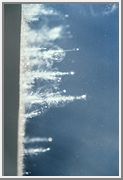|
COMETS EARTH JUPITER KUIPER BELT MARS MERCURY METEORITES NEPTUNE OORT CLOUD PLUTO SATURN SOLAR SYSTEM SPACE SUN URANUS VENUS ORDER PRINTS
PHOTO CATEGORIES SCIENCEVIEWS AMERICAN INDIAN AMPHIBIANS BIRDS BUGS FINE ART FOSSILS THE ISLANDS HISTORICAL PHOTOS MAMMALS OTHER PARKS PLANTS RELIGIOUS REPTILES SCIENCEVIEWS PRINTS
|
Related Document
Download Options
Aerogel Quick Facts
Catching Comet Dust The primary objective of the Stardust mission is to capture both cometary samples and interstellar dust. Main challenges to accomplishing this successfully involve slowing down the particles from their high velocity with minimal heating or other effects that would cause their physical alteration. When the Stardust Spacecraft encounters the Comet Wild 2, the impact velocity of the particles will be up to 6 times the speed of a rifle bullet. Although the captured particles will each be smaller than a grain of sand, high-speed capture could alter their shape and chemical composition - or even vaporize them entirely. To collect particles without damaging them, Stardust uses an extraordinary substance called aerogel. This is a silicon-based solid with a porous, sponge-like structure in which 99.8 percent of the volume is empty space. By comparison, aerogel is 1,000 times less dense than glass, which is another silicon-based solid. When a particle hits the aerogel, it buries itself in the material, creating a carrot-shaped track up to 200 times its own length. This slows it down and brings the sample to a relatively gradual stop. Since aerogel is mostly transparent - with a distinctive smoky blue cast - scientists will use these tracks to find the tiny particles. |
